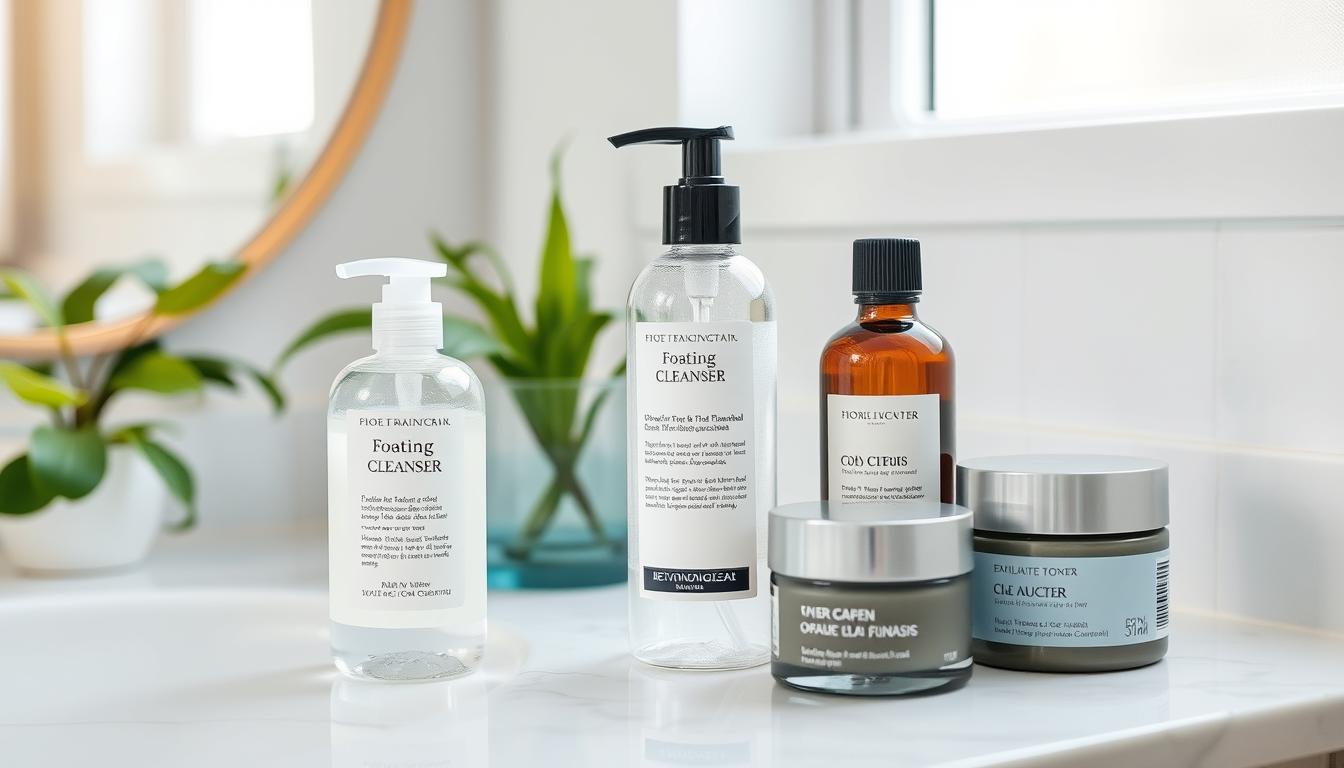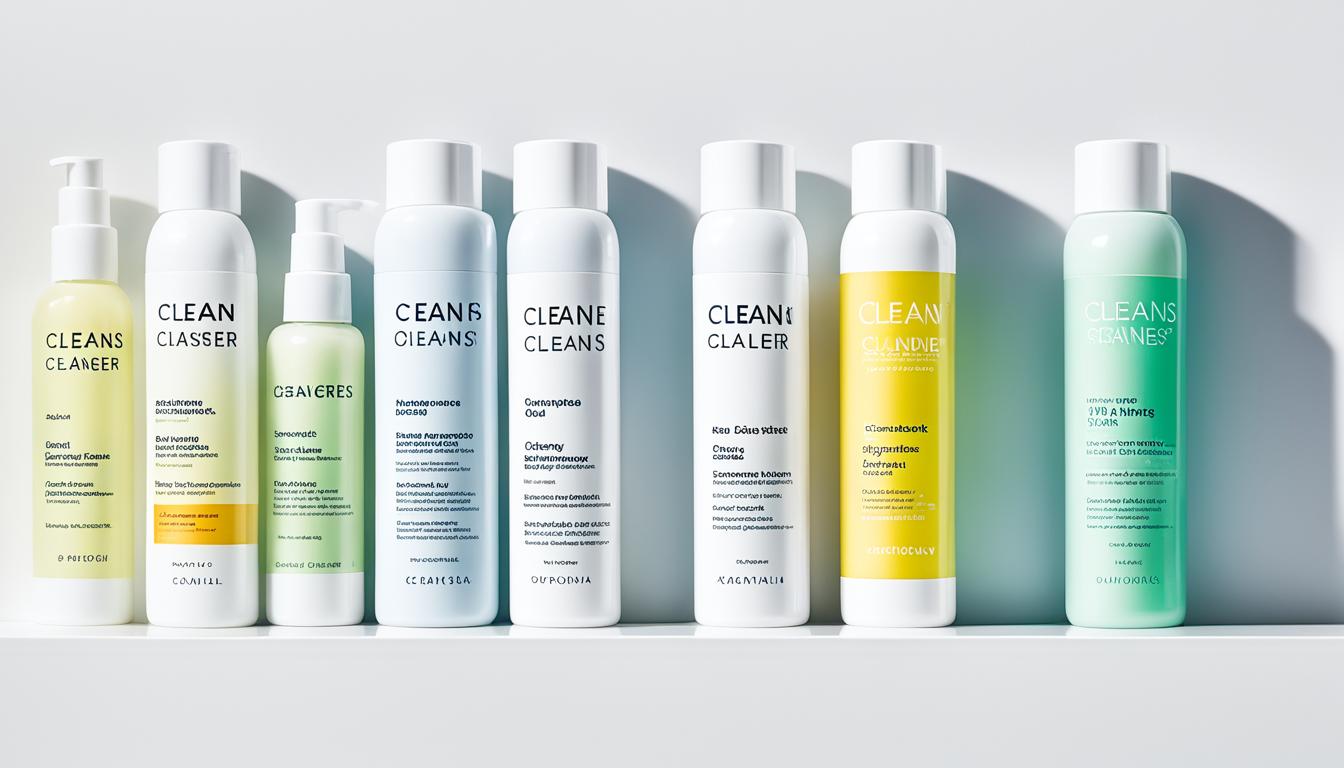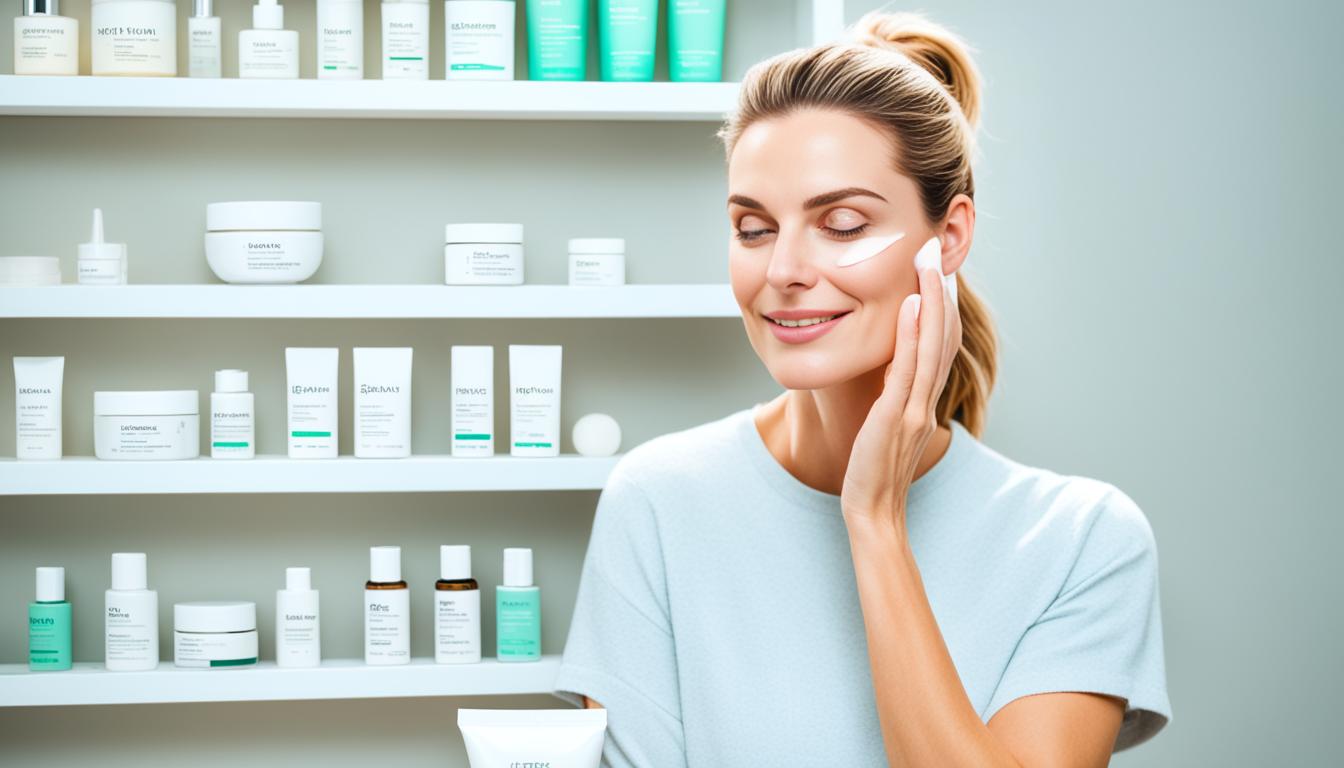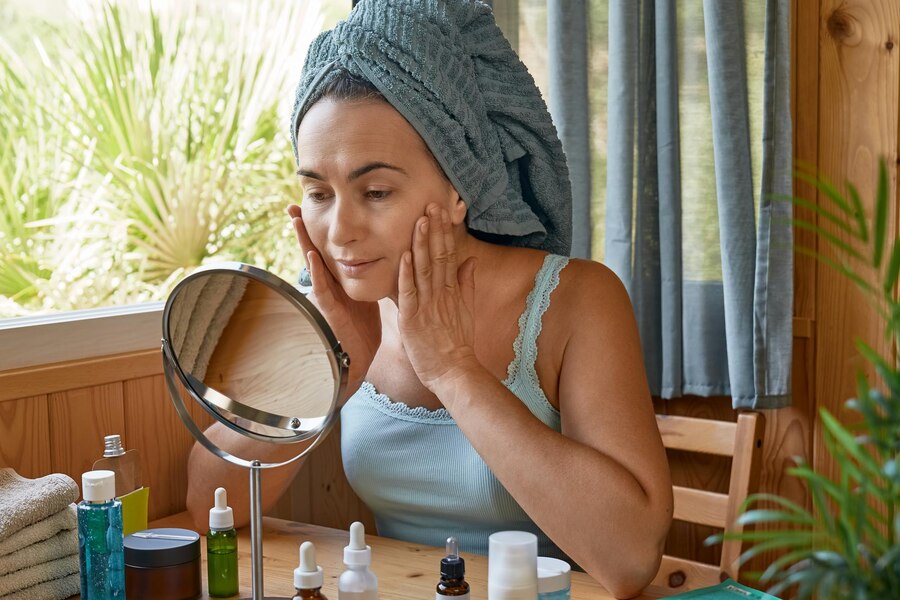What Is Rosacea And Its Symptoms?

Rosacea is a chronic skin issue that leads to facial redness, flushing, and pimple-like bumps. It usually affects the middle part of your face. This includes the nose, cheeks, and forehead. Many people confuse it with acne or dermatitis.
Even though we can’t cure rosacea, its effects can be controlled. This can be done through certain medications, careful skin care, and avoiding triggers. These triggers include sun exposure, hot drinks, and stress.
It is most common among adults in their middle years and older. It is also more likely to happen to those with fair skin or if it runs in the family. Symptoms differ from person to person. They might lessen or worsen because of sun, stress, or heat.
Key Takeaways
- Rosacea is a common, chronic skin condition that causes facial redness, flushing, and visible blood vessels.
- Rosacea can be mistaken for other skin problems like acne or dermatitis.
- While there is no cure, rosacea can be managed with medication, gentle skin care, and lifestyle modifications.
- Rosacea is more common in middle-aged and older adults, fair-skinned individuals, and those with a family history.
- Symptoms can vary and may come and go, with certain triggers like sun exposure and stress known to exacerbate flare-ups.
Understanding Rosacea
Rosacea is a skin condition that can show up differently on people with different skin tones. It’s known for causing facial redness, flushing, and visible blood vessels. But, how it appears can be unique for different individuals.
Also Read : Discovering The Best PHD Scholarships For USA Students
Rosacea on White Skin
People with lighter skin might see red patches, small bumps, and pus-filled lesions in the central face area. This includes the cheeks, nose, and forehead. The contrast between the red areas and the rest of the face is striking, making it stand out.
Also Read : Exploring PHD Scholarship Opportunities In 2024
Rosacea on Brown Skin
But, for those with deeper skin, the flushing and redness can be harder to spot. This is because the skin color variations can mask the typical signs. Yet, if you notice facial irritation, sensitivity, and small bumps, it might still be rosacea.
Also Read : How To Applying For Merit Based MBA Scholarship Programs ?
Overview of Rosacea
Regardless of your skin color, rosacea is a chronic, inflammatory skin condition affecting the face. It leads to constant facial redness, flushing, visible blood vessels, and, sometimes, skin thickening on the nose. While there’s no cure, it can be well managed with medical treatments, lifestyle changes, and careful skincare.
Also Read : Global MBA Scholarships For International Students
| Rosacea on White Skin | Rosacea on Brown Skin |
|---|---|
| Distinct red patches, small bumps, and pus-filled lesions on the central face | Subtle flushing and redness, making it more difficult to detect |
| Pronounced contrast between inflamed areas and surrounding skin | Persistent facial irritation, sensitivity, and small bumps |
| Readily identifiable signs of rosacea | Potential for delayed diagnosis or misdiagnosis |
Symptoms of Rosacea
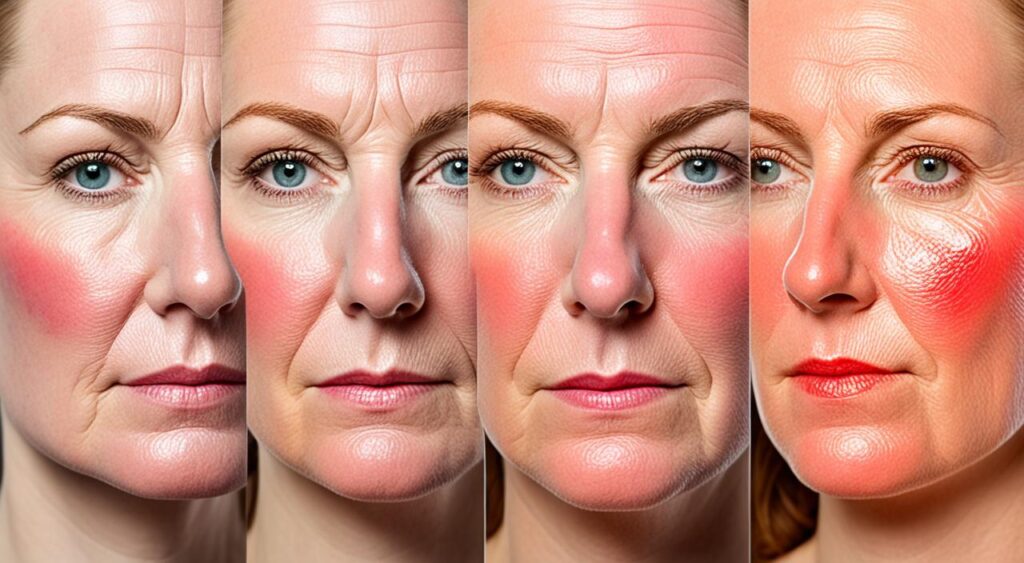
Rosacea is more than red skin; it’s a long-lasting condition with its own set of symptoms. Knowing what to look for is key in dealing with how it makes us look and feel.
Also Read : MBA Scholarship Programs In USA
Facial Redness and Flushing
Rosacea often shows as a constant redness on the face, with occasional flare-ups that create a flush. The redness mainly appears on the nose, cheeks, forehead, and chin, forming what’s called a “butterfly” pattern on the face.
Visible Blood Vessels
Over time, small, visible blood vessels can start to show on the skin, known as spider veins. These tiny veins add to the overall red look of the skin.
Swollen Bumps and Pimples
Some people with rosacea get swollen, red bumps or pimples, which can look like a type of acne. This type, acne rosacea, can be tough and needs specific treatment.
Burning Sensation
It might also feel like the skin is burning, stinging, or itching for those with rosacea. This can get worse with triggers like the weather or specific products.
Eye Problems and Ocular Rosacea
Rosacea could even affect the eyes, leading to ocular rosacea. It might cause the eyes to be red, watery, and feel gritty or like there’s something in them.
Enlarged Nose (Rhinophyma)
In a few cases, rosacea can make the nose bigger, called rhinophyma. This symptom is more common in men and usually shows up after many years of severe rosacea.
Rosacea

Rosacea is a long-lasting issue that makes your face red, and sometimes swollen. It’s common but often confused with other conditions. While not curable, it can be controlled with the right care.
The exact cause of rosacea is a bit of a mystery. Experts think genes and the environment play a role. Things like the hot sun, warm drinks, and stress can make it worse.
People in their middle age or older are more likely to get rosacea, especially women. It affects those with light skin more, but anyone can develop it.
Even though there’s no complete fix for rosacea, many treatments can help. These include creams, pills, and special light treatments. It’s important to see a skin doctor for the best plan for you.
Who Gets Rosacea?
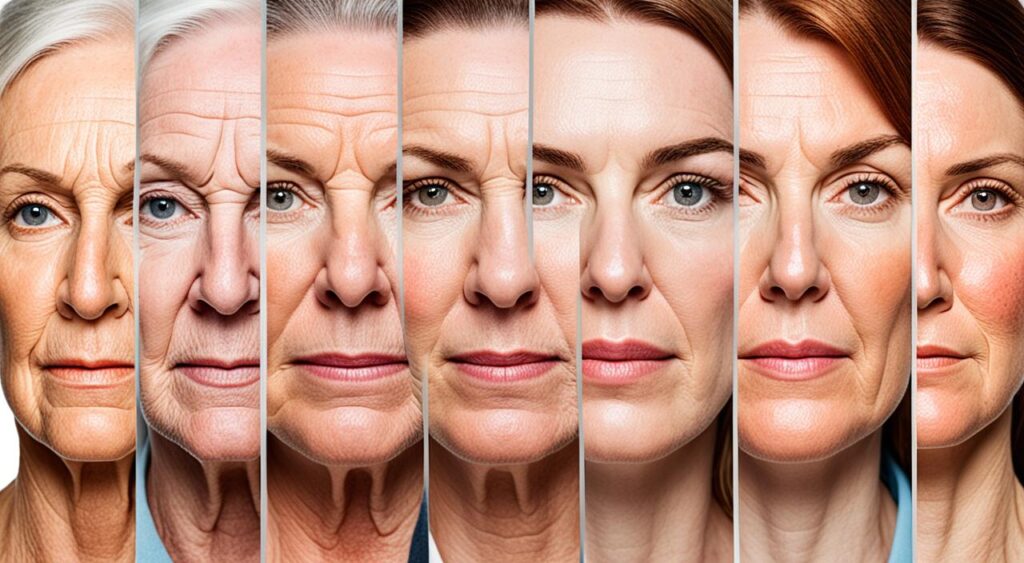
Rosacea is a skin issue that makes the face red and have visible veins. It can happen to anyone, regardless of age, gender, or skin color. Knowing who is more likely to get rosacea helps us manage and prevent it better.
Middle-aged and Older Adults
This condition is seen more in people aged 30 to 50. As we get older, our skin loses some ability to handle blood flow and temperature. This makes rosacea more common and can even make the symptoms worse.
Gender Differences
More women get diagnosed with rosacea than men. But, when men do get it, they often have a more severe form. This includes a subtype called rhinophyma, where the nose gets larger and thicker.
Fair Skin Tones
Those with fair skin are more prone to rosacea. It shows up more obviously on lighter skin tones. However, rosacea can happen in people with darker skin, too. It’s just harder to spot because symptoms are not as clear.
Family History and Genetics
Having a family member with rosacea can up your risk for it. This hints at a genetic link. It suggests that traits passed down in families might play a role in getting rosacea.
Causes and Triggers of Rosacea
The cause of rosacea is still a mystery, but we know genes and the world around us play a big part. Things like redness, flushing, and other issues can get worse because of certain triggers.
Sun and Wind Exposure
For many people with rosacea, the sun and strong wind are not friends. They can make the skin inflamed and spark symptoms. Using sunscreen and wearing protective clothes can shield your face and reduce these problems.
Hot Beverages and Spicy Foods
Hot drinks and spicy meals can make blood vessels open up, causing more redness. Eating less of these foods and drinks can make your skin feel better.
Alcohol Consumption
Red wine and other alcohols make blood vessels get bigger, leading to more redness and flushing. Cutting back on alcohol or not drinking can lower the number of flare-ups you get.
Extreme Temperatures
Any weather that’s very hot or very cold can set off rosacea. Jumping from a toasty room into the cold can stress your blood vessels, making your face flush or flare up.
Emotional Stress
Feeling anxious can make rosacea worse. Stress makes your body react in ways that can show more signs of rosacea. Finding ways to relax, like meditation, can be good for your skin.
Exercise
Working out is great for health but can be a trigger for rosacea because it makes you sweat and increases blood flow. Choosing cooler exercises and environments might be better for your skin.
Certain Medications
Some drugs can make rosacea symptoms worse. If you’re starting new medication, talk to your doctor to make sure it won’t affect your skin badly.
Cosmetic Products
Some skincare and makeup can also irritate skin and cause flare-ups. Choose products that are gentle, without fragrances, and don’t hurt your skin to help keep rosacea under control.
Diagnosing Rosacea
Diagnosing rosacea usually starts with a deep look by a healthcare pro, often a skin doctor. They’ll check out the patient’s symptoms and any skin signs. This look is key because rosacea may seem like other skin troubles, such as acne or eczema.
For a clearer look at rosacea, the doctor might use imaging or special skin tests. These extra checks help make sure it’s really rosacea and not something else, showing signs like inflamed or sensitive skin.
The doctor gets the full info by looking closely at the patient and considering their history and symptoms. This way, they can confirm if it’s rosacea and make a plan to treat it. This detailed check is crucial for the right treatment and to slow down rosacea’s process.
Treatment Options for Rosacea

Rosacea doesn’t have a cure yet, but treatments can help control it. Doctors suggest different methods based on an individual’s needs and how bad their symptoms are.
Topical Medications
Creams or gels with ingredients such as metronidazole or azelaic acid can lessen redness and swelling. These are often the first treatments to try for the obvious signs of rosacea.
Oral Antibiotics
If needed, doctors may give oral antibiotics to reduce inflammation and control bacteria. This works well for serious or long-lasting cases of rosacea.
Laser and Light Therapies
For tough cases, treatments with laser or light might be advised. This includes IPL or PDT. They aim to fade blood vessels, lessen redness, and boost skin look.
Surgical Procedures
Extremely rare, situations like rhinophyma may need surgery to fix. This surgery can better the person’s look and confidence.
Lifestyle Modifications
Changing some habits also helps. This could mean staying away from triggers, using mild products, shield the skin from the sun, and managing stress.
Working with a skin doctor or healthcare expert is key. They can design a plan that uses different treatments to keep rosacea under control. This not only helps the skin but also the person’s overall health and happiness.
Managing Rosacea Flare-ups
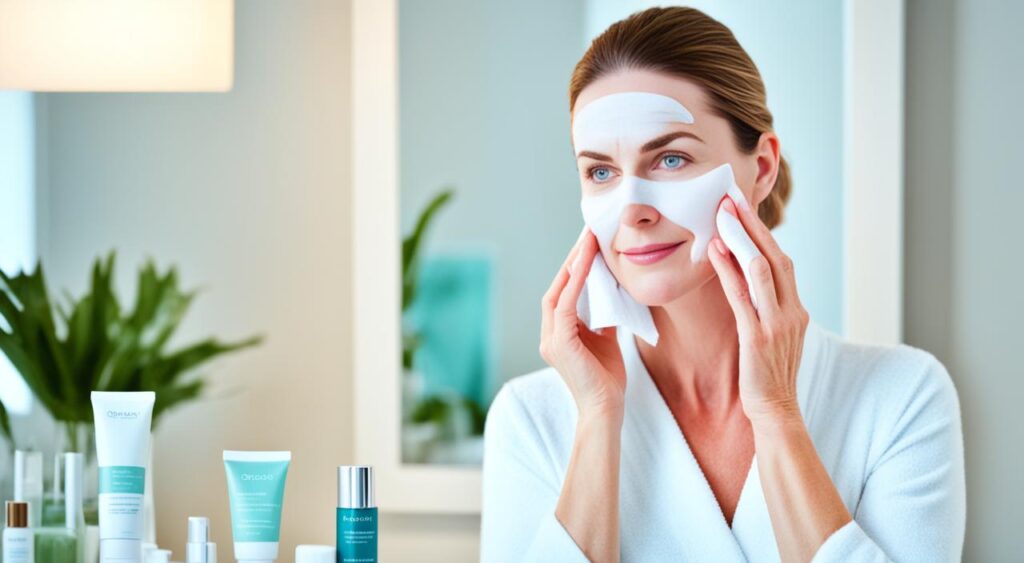
Rosacea is a skin issue that comes and goes over time. To handle flare-ups, you should know and avoid what makes them worse. This includes gentle skin care, staying out of the sun, lowering stress, and smart dietary choices.
Identifying Triggers
To start, figure out what makes your rosacea act up. This could be the sun, hot drinks, spicy food, cold or hot weather, stress, or some medicines. Once you know what triggers your flare-ups, you can change things to help your skin stay calm.
Gentle Skin Care
Choosing the right skincare products is key for rosacea. Use only mild, unscented products. Stay away from harsh cleansers and anything that might irritate your skin. Look for products made for sensitive skin or for rosacea.
Sun Protection
Sun protection is extremely important for those with rosacea. Sunlight can make your symptoms worse. Use sunscreen every day, with at least SPF 30. Try to stay in the shade or wear clothes that protect your face if you’re outside.
Stress Management
Stress is a big trigger for rosacea. Find ways to relax, like deep breathing or doing hobbies you enjoy. Managing stress can really help keep your skin condition in check.
Dietary Changes
What you eat and drink can also affect your rosacea. Spicy foods, hot drinks, and alcohol can make it worse. Try to avoid these. Drink plenty of water and eat foods that fight inflammation, like those high in omega-3s.
Using these tips, people with rosacea can be in control. By understanding their triggers and making healthy choices, they can cope with their condition. This can make a big difference in how they feel every day.
Also read: 8 Signs Of Unhealthy Skin
Conclusion
Rosacea is a common, long-lasting skin problem mainly on the face. It leads to redness, flushing, and visible blood vessels. Sometimes, it also causes swollen bumps and pimples. There is no cure, but treatment can help a lot. This includes using creams, taking oral medicine, and changing some habits.
To manage rosacea, avoiding things that make it worse is key. This includes triggers, gentle skincare, and sun protection. Managing stress and having a healthy diet also helps. Consulting a healthcare pro, like a dermatologist, is important. They can give you a treatment plan that fits your needs.
With the right steps, managing rosacea is possible. By being aware and taking action, people can control their skin’s health. This leads to a better life quality. Finding the right support resources plays a big role. It helps in keeping rosacea in check. This way, its effects on daily life are reduced.
FAQs
What is rosacea?
Rosacea is a skin condition that leads to facial redness, flushing, and visible blood vessels. It also causes pimple-like bumps. Often, it shows up in the center of the face, like the nose and cheeks.
What are the common symptoms of rosacea?
The main signs of rosacea are redness and flushing on the face. You might see blood vessels or spider veins. Swollen bumps and a burning feeling are also common.
What’s more, some people get pimple-like lesions. Eye irritation, known as ocular rosacea, and a rare large, swollen nose (rhinophyma) are also symptoms.
Who is more likely to develop rosacea?
Rosacea often hits middle-aged or older adults, 30 to 50 years old. Women get it more, but it’s worse in men. Fair skin is known to boost your risk, but people with all skin tones can get it.
What causes rosacea and what are common triggers?
The cause of rosacea isn’t fully clear. But, genes and the environment seem to be part of it. Things that can make it worse include sun and wind, hot drinks and spicy foods, and drinking alcohol.
Extreme temperatures, stress, working out, some medicines, and certain cosmetics are also triggers.
How is rosacea diagnosed?
Doctors, like dermatologists, diagnose rosacea. They check your skin and ask about your symptoms. Sometimes, they do more tests to make sure it’s rosacea and not something else.
What are the treatment options for rosacea?
There’s no cure for rosacea, but treatments can help. These include creams, antibiotics, and therapies that use light or laser. Surgery is an option too.
Changing your lifestyle, like avoiding triggers and taking care of your skin, is important. Protecting your skin from the sun is key.
How can I manage rosacea flare-ups?
Managing flare-ups is about spotting and dodging what makes them worse. Use gentle, fragrance-free skin stuff and shield your face from the sun.
Stress management and a healthy diet also play a big part in keeping rosacea under control.

